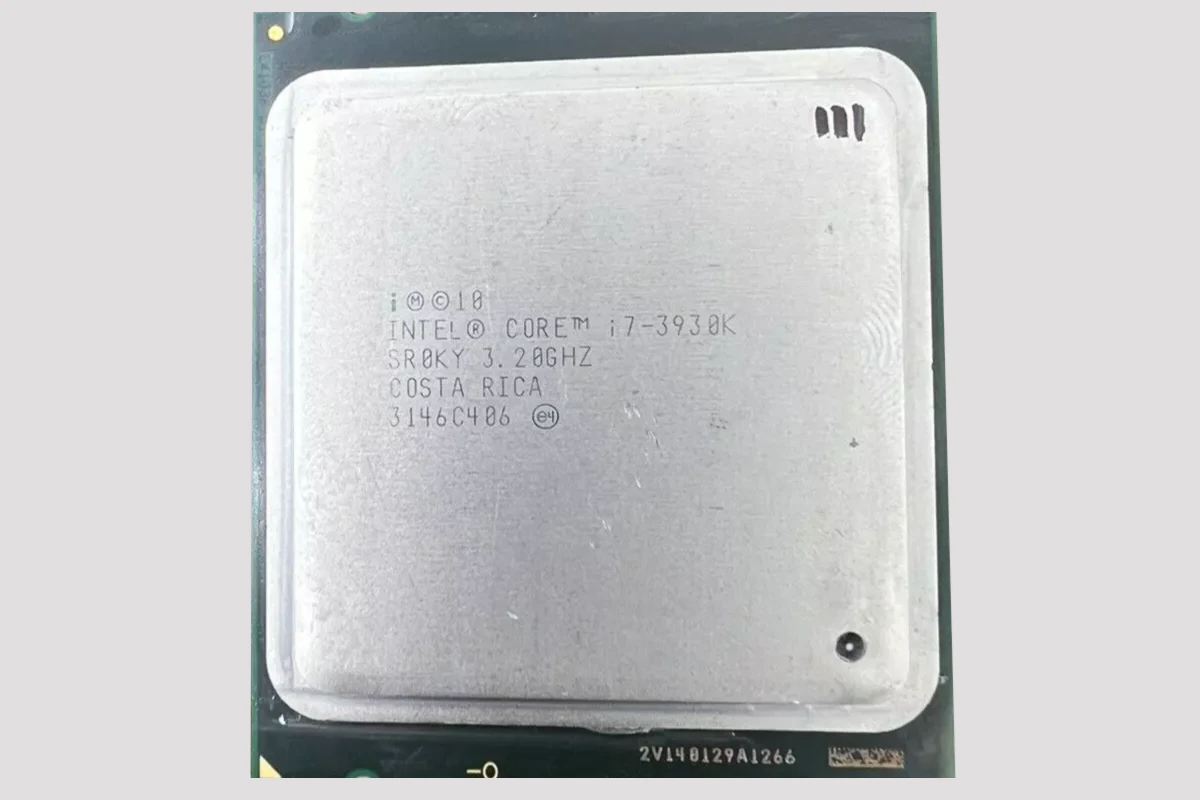LGA 2011 is a CPU socket used in high-end desktops and servers. It supports a range of Intel processors, including Core i7 and Xeon models. The LGA 2011 socket can house CPUs with up to 8 cores and 16 threads, making it ideal for demanding tasks like video editing and 3D rendering.
This socket was introduced in 2011 and has gone through several generations. Each version brought improvements in speed, power efficiency, and features. The LGA 2011 platform supports quad-channel DDR3 or DDR4 memory, depending on the specific CPU and motherboard.
For those building or upgrading a powerful computer, knowing which CPUs work with LGA 2011 is key. The list includes chips from the Sandy Bridge-E, Ivy Bridge-E, and Haswell-E families. These processors offer a mix of high clock speeds and many cores, catering to different user needs and budgets.
LGA 2011 CPU List
| Name | Core Count | Core Clock | Microarchitecture | TDP |
|---|---|---|---|---|
| Intel Core i7-3930K | 6 | 3.2 GHz | Sandy Bridge | 130 W |
| Intel Xeon E5-2640 | 6 | 2.5 GHz | Sandy Bridge | 95 W |
| Intel Xeon E5-4620 | 8 | 2.2 GHz | Sandy Bridge | 95 W |
| Intel Core i7-3820 | 4 | 3.6 GHz | Sandy Bridge | 130 W |
| Intel Xeon E5-2650 | 8 | 2 GHz | Sandy Bridge | 95 W |
| Intel Xeon E5-2680 | 8 | 2.7 GHz | Sandy Bridge | 130 W |
| Intel Core i7-3960X Extreme Edition | 6 | 3.3 GHz | Sandy Bridge | 130 W |
| Intel Core i7-3970X Extreme Edition | 6 | 3.5 GHz | Sandy Bridge | 150 W |
| Intel Xeon E5-2670 | 8 | 2.6 GHz | Sandy Bridge | 115 W |
| Intel Xeon E5-2690 | 8 | 2.9 GHz | Sandy Bridge | 135 W |
| Intel Xeon E5-2650L | 8 | 1.8 GHz | Sandy Bridge | 70 W |
| Intel Xeon E5-1650 | 6 | 3.2 GHz | Sandy Bridge | 130 W |
| Intel Xeon E5-1620 | 4 | 3.6 GHz | Sandy Bridge | 130 W |
| Intel Xeon E5-2687W | 8 | 3.1 GHz | Sandy Bridge | 150 W |
| Intel Xeon E5-4650 | 8 | 2.7 GHz | Sandy Bridge | 130 W |
| Intel Xeon E5-2665 | 8 | 2.4 GHz | Sandy Bridge | 115 W |
| Intel Xeon E5-1660 | 6 | 3.3 GHz | Sandy Bridge | 130 W |
| Intel Xeon E5-2603 | 4 | 1.8 GHz | Sandy Bridge | 80 W |
| Intel Xeon E5-2630 | 6 | 2.3 GHz | Sandy Bridge | 95 W |
| Intel Xeon E5-2660 | 8 | 2.2 GHz | Sandy Bridge | 95 W |
| Intel Xeon E5-2620 | 6 | 2 GHz | Sandy Bridge | 95 W |
| Intel Xeon E5-2609 | 4 | 2.4 GHz | Sandy Bridge | 80 W |
| Intel Xeon E5-2630 V2 | 6 | 2.6 GHz | Ivy Bridge | 80 W |
| Intel Core i7-4930K | 6 | 3.4 GHz | Ivy Bridge | 130 W |
| Intel Core i7-4820K | 4 | 3.7 GHz | Ivy Bridge | 130 W |
| Intel Core i7-4960X Extreme Edition | 6 | 3.6 GHz | Ivy Bridge | 130 W |
| Intel Xeon E5-2697 V2 | 12 | 2.7 GHz | Ivy Bridge | 130 W |
| Intel Xeon E5-2650 V2 | 8 | 2.6 GHz | Ivy Bridge | 95 W |
| Intel Xeon E5-2695 V2 | 12 | 2.4 GHz | Ivy Bridge | 115 W |
| Intel Xeon E5-2690 V2 | 10 | 3 GHz | Ivy Bridge | 130 W |
| Intel Xeon E5-1650 V2 | 6 | 3.5 GHz | Ivy Bridge | 130 W |
| Intel Xeon E5-2687W V2 | 8 | 3.4 GHz | Ivy Bridge | 150 W |
| Intel Xeon E5-2667 V2 | 8 | 3.3 GHz | Ivy Bridge | 130 W |
| Intel Xeon E5-1620 V2 | 4 | 3.7 GHz | Ivy Bridge | 130 W |
| Intel Xeon E5-2680 V2 | 10 | 2.8 GHz | Ivy Bridge | 115 W |
| Intel Xeon E5-2670 V2 | 10 | 2.5 GHz | Ivy Bridge | 115 W |
| Intel Xeon E5-2643 V2 | 6 | 3.5 GHz | Ivy Bridge | 130 W |
| Intel Xeon E5-2630L V2 | 6 | 2.4 GHz | Ivy Bridge | 60 W |
| Intel Xeon E5-2650L V2 | 10 | 1.7 GHz | Ivy Bridge | 70 W |
| Intel Xeon E5-2620 V2 | 6 | 2.1 GHz | Ivy Bridge | 80 W |
| Intel Xeon E5-1660 V2 | 6 | 3.7 GHz | Ivy Bridge | 130 W |
| Intel Xeon E5-2660 V2 | 10 | 2.2 GHz | Ivy Bridge | 95 W |
| Intel Xeon E5-2603 V2 | 4 | 1.8 GHz | Ivy Bridge | 80 W |
| Intel Xeon E5-2640 V2 | 8 | 2 GHz | Ivy Bridge | 95 W |
| Intel Xeon E5-2637 V2 | 4 | 3.5 GHz | Ivy Bridge | 130 W |
| Intel Xeon E5-2609 V2 | 4 | 2.5 GHz | Ivy Bridge | 80 W |
Key Takeaways
- LGA 2011 supports high-end Intel Core i7 and Xeon processors
- CPUs for this socket offer up to 8 cores and 16 threads
- The platform works with quad-channel DDR3 or DDR4 memory
Overview of LGA 2011 CPUs
LGA 2011 CPUs are powerful processors designed for high-end desktops and servers. They offer strong performance for demanding tasks like gaming and content creation.
LGA 2011 Architecture and Features
LGA 2011 CPUs use Intel’s Sandy Bridge and Ivy Bridge architectures. These chips have up to 8 cores and 16 threads. They support quad-channel memory for faster data access. The CPUs also have large caches, often 20MB or more. This helps speed up frequent tasks.
LGA 2011 processors come in two main types:
- Core i7 for desktops
- Xeon E5 for servers
Both offer high clock speeds and Turbo Boost for extra performance when needed. They also support PCI Express 3.0 for fast connections to graphics cards and other devices.
Evolution of LGA 2011 Processors
Intel released LGA 2011 in 2011 as a replacement for LGA 1366. The first chips were based on Sandy Bridge. Later versions used Ivy Bridge, which improved efficiency.
Key milestones:
- 2011: First LGA 2011 CPUs launch
- 2013: Ivy Bridge-E refresh
- 2014: LGA 2011-v3 arrives with Haswell-E
Each new version brought more cores, faster speeds, and better features. The socket stayed the same, but newer CPUs needed updated motherboards.
LGA 2011 Versus Other Sockets
LGA 2011 stands out from other CPU sockets in several ways:
- More pins (2011 vs 1155 for mainstream CPUs)
- Support for more cores and threads
- Quad-channel memory instead of dual-channel
- Higher power draw and heat output
These features make LGA 2011 CPUs better for heavy workloads. They excel in tasks that use many cores. But they cost more and use more energy than mainstream options.
For most users, LGA 1155 or 1150 CPUs were enough. LGA 2011 was aimed at enthusiasts and professionals who needed extra power.







